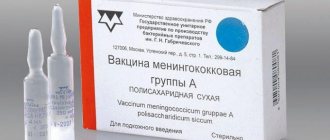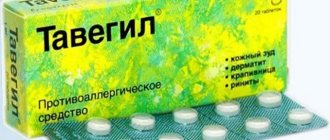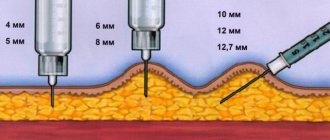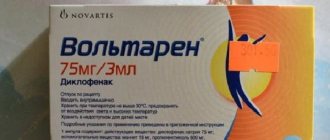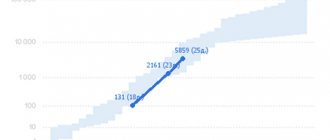Write a review
Reviews: 0
Manufacturers: Sanofi-Aventis
Active ingredients
- Hepatitis A vaccine (inactivated adsorbed)
Disease class
- Acute hepatitis A
Clinical and pharmacological group
- Not indicated. See instructions
Pharmacological action
- Immunostimulating
Pharmacological group
- Antiviral agents
- Vaccines, serums, phages and toxoids
Release form and composition
Avaxim 80 is produced in the form of a suspension for intramuscular administration: a turbid, whitish liquid (1 dose in glass syringes type 1 with a capacity of 1 ml with a fixed stainless steel needle with a protective cap and an elastomer piston, 1 syringe in a transparent closed cell packaging (blister) ), 1 package (blister) in a cardboard box).
The composition of 1 dose (0.5 ml) of suspension includes:
- Active substance: inactivated hepatitis A virus – 80 units (units, expressed using the manufacturer’s internal reference standard);
- Auxiliary components: aluminum hydroxide – 0.15 mg (in terms of aluminum), formaldehyde – 0.0125 mg, 2-phenoxyethanol – 0.0025 ml, Hanke’s medium 199 (a mixture of amino acids, mineral salts, vitamins and other components dissolved in water for injection) - up to 0.5 ml, hydrochloric acid or sodium hydroxide - in the volume necessary to adjust the pH value.
Contraindications
Absolute:
- Diseases occurring with fever, acute or chronic infectious diseases in the acute stage (vaccination is possible 2-4 weeks after recovery or during remission or convalescence; in case of mild acute respiratory viral infections, in case of acute intestinal infections, vaccinations are carried out immediately after the temperature has normalized );
- Systemic hypersensitivity reactions or life-threatening reactions to previous administration of Avaxim 80 or a vaccine containing similar components;
- Allergy to the components of the drug.
Relative (use of Avaxim 80 is possible only with caution in the presence of the following diseases/conditions):
- Thrombocytopenia or disorders of the blood coagulation system (due to the likelihood of bleeding after intramuscular injection). After the injection, such patients need to apply a pressure bandage for at least 2 minutes. In exceptional cases, subcutaneous administration of the drug is possible;
- Hypersensitivity to formaldehyde, neomycin or other antibiotic drugs of this class;
- Pregnancy and lactation (the use of Avaxim 80 in pregnant women is not recommended (due to the lack of necessary data); the decision to vaccinate should be made only if there are clear indications after weighing the benefit against the risk).
Before administering vaccination, a healthcare worker must take all measures necessary to prevent the development of anaphylactoid or anaphylactic reactions at the time of vaccination (necessary medications, including adrenaline, must be available).
The cause of a weak immune response to the vaccine may be immunodeficiency conditions or immunosuppressive therapy. In these cases, it is recommended to postpone vaccination until recovery or completion of treatment. However, Avaxim 80 is prescribed to patients with chronic immunodeficiencies, such as HIV infection, even in cases where the immune response to its administration may be reduced due to the underlying disease.
Insertion of a needle can provoke psychogenic fainting (in the form of weakness, loss of consciousness); In this regard, vaccination must be carried out in conditions that allow one to avoid injury from a fall and provide the necessary medical care.
Directions for use and dosage
The drug is administered intramuscularly, into the deltoid muscle of the shoulder, for children under 2 years old - into the upper outer region of the thigh. The suspension should not be administered into the gluteal region or intradermally (possibly weakening the immune response). Introduction into the vascular bed is strictly prohibited (you should make sure that the needle does not enter a blood vessel).
Before vaccination, the syringe with Avaxim 80 should be shaken well until a homogeneous suspension is obtained.
Single dose – 0.5 ml.
Mixing Avaxim 80 in one syringe with other vaccines is prohibited!
In order to ensure long-term immunity, revaccination should be carried out with the same dose after 6 months or up to 3 years after the first dose.
In immunocompetent individuals, there is no need for revaccination after double vaccination.
The vaccine should not be used if its color changes or if foreign particles are present. Remains of unused vaccine are disposed of.
Inactivated vaccine for the prevention of Hepatitis A “Avaxim”
Sanofi Pasteur, France
Release form: 1 syringe/1 dose/0.5 ml for adults and children over 2 years old.
Vaccination schedule: twice, day 0 – 6(18) months. Revaccination every 10 years.
INSTRUCTIONS FOR USE of the inactivated vaccine for the prevention of Hepatitis A "Avaxim"
COMPOSITION One dose (0.5 ml) of the vaccine contains: - Hepatitis A virus*, inactivated by formaldehyde 160 antigenic units** - Aluminum hydroxide (expressed in Al) 0.3 mg - 2-phenoxyethanol 2.5 µl - Formaldehyde 12, 5 mcg - Hanks 199 medium*** up to 0.5 ml - Hydrochloric acid or sodium hydroxide to adjust pH.
* GBM strain cultured on human diploid cells (MRC5). ** In the absence of an international reference standard, antigen content is expressed using an internal reference standard. *** Hanks 199 medium is a complex mixture of amino acids, mineral salts, vitamins and other ingredients dissolved in water for injection; The pH is adjusted by adding hydrochloric acid or sodium hydroxide.
RELEASE FORM Suspension for injection: syringe containing 1 dose of vaccine (0.5 ml).
LICENSE HOLDER FOR THE SALE OF PASTeur MERRIER Sirome & Vaxin, 58, Avenue Leclerc, 69007 LYON-FRANCE
INDICATIONS This drug is a VACCINE - AVAXIM is intended for the prevention of infection caused by the hepatitis A virus in adults and children over 2 years of age. — Vaccine prevention of hepatitis A is recommended for the following risk groups: · unimmunized persons traveling to endemic regions (with high incidence of hepatitis A) · persons at occupational risk of infection: nursing staff (including those caring for adults and children wheelchair users), sewer and water supply personnel, food industry and catering workers. · persons from special risk groups (patients with hemophilia, patients with multiple blood transfusions, drug addicts who use drugs intravenously, homosexuals). · children over 2 years of age living in endemic regions (with a high incidence of hepatitis A). — Vaccination with this drug does not prevent viral hepatitis of other etiologies, as well as infections caused by other known hepatotropic microorganisms. The vaccine is available with a doctor's prescription.
CONTRAINDICATIONS Vaccination SHOULD NOT BE CARRIED OUT in the following cases: - with elevated body temperature, acute or chronic progressive diseases (it is advisable to postpone vaccination until the condition normalizes). - in case of hypersensitivity to any component of the vaccine or an allergic reaction observed during the previous administration of the vaccine. In difficult cases, you should consult a doctor.
WARNINGS
- Do not administer intravenously: make sure that the needle does not enter a blood vessel. — The vaccine should not be administered into the gluteal muscles (due to variability in the thickness of the fat layer) or intradermally, since in these cases the induction of a reduced intensity immune response is possible.
- Immunosuppressive therapy or an immunodeficiency condition may cause a poor immune response to the vaccine. — Vaccination carried out during the incubation period of hepatitis A disease may be ineffective.
NOTES FOR USE This drug should be used with CAUTION in patients: - with liver disease, - with hypersensitivity to neomycin (each dose of the vaccine contains trace amounts of neomycin). Keep the vaccine out of the reach of children. In difficult cases, you should consult a doctor.
DRUG INTERACTIONS The vaccine can be administered simultaneously with immunoglobulins, provided that different parts of the body are used to inject the vaccine and immunoglobulins. Since this vaccine is inactivated, combination with other inactivated vaccines should not affect the effectiveness of vaccination provided the vaccines are administered to different parts of the body. In particular, the vaccine can be used simultaneously with a recombinant vaccine for the prevention of hepatitis B, typhoid vaccine, and a live vaccine for the prevention of yellow fever. In addition, this vaccine can be used for revaccination and in cases where the previous vaccination was carried out with other inactivated vaccines for the prevention of hepatitis A. In order to avoid possible interactions with other drugs, it is necessary to inform the doctor about any medication taken before or during vaccination time.
PREGNANCY AND BREASTFEEDING The effects of this drug on the embryo or fetus have not been studied. However, as with any other inactivated viral vaccine, it is unlikely that this drug will cause adverse effects on the embryo or fetus. However, the vaccine is not recommended for pregnant women. The decision to vaccinate pregnant or breastfeeding women should be made only on the basis of an assessment of the real risk of contracting hepatitis A. The effect of this vaccine has not been studied during breastfeeding, so its use during this period is not recommended.
LIST OF INGREDIENTS THAT MAY AFFECT SOME PATIENTS Formaldehyde.
DOSAGE AND REGULATION OF APPLICATION The recommended dose is 0.5 ml for each administration. Primary vaccination is carried out with a single dose of the vaccine. Revaccination is carried out with a single dose every 6-18 months. Based on available data, subsequent booster vaccinations are recommended every 10 years.
METHOD OF ADMINISTRATION In order to reduce the likelihood of local reactions, AVAKSIM is recommended to be administered intramuscularly into the deltoid muscle (shoulder muscle). When inserting, you must make sure that the needle does not penetrate into the blood vessel. The vaccine should not be administered into the gluteal muscles (due to variability in the thickness of the fat layer) or intradermally, since in these cases the induction of a reduced immune response may occur. In special cases - in patients with thrombocytopenia or bleeding, the vaccine can be administered subcutaneously. The vaccine cannot be mixed with other vaccines in the same syringe.
ADVERSE REACTIONS Administration of this vaccine (as with any other active drug) in some hypersensitive individuals may result in the following side effects of varying severity: - pain and redness at the injection site. Very rarely there is a lump at the injection site. - a moderate increase in body temperature, feeling tired, headache, muscle or joint pain, and gastrointestinal disorders are the most common adverse reactions. - a slight reversible increase in the activity of liver enzymes (transaminases) - was noted in rare cases.
Tell your doctor if there are any unusual side effects not listed in this leaflet. About all cases of unusual vaccination reactions, inform the National Control Authority (NOC) for medical immunobiological preparations - the State Research Institute for Standardization and Control of Medical Biological Preparations named after. L.A. Tarasevich (121002, Moscow, Sivtsev-Vrazhek lane, 41, tel. 241-89-22 and representative office of the manufacturer (101000, Moscow, Ulansky lane, 5, tel. 935-86-90).
STORAGE
- At temperatures from +2°C to +8°C (in the refrigerator).
- Do not freeze.
- Do not use after the expiration date stated on the packaging.
SHELF LIFE 24 months.
← Back
Side effects
All disorders identified as a result of clinical studies were mild, short-term in nature and resolved independently without additional treatment.
Possible adverse reactions (> 10% - very common; > 1% and < 10% - often; > 0.1% and < 1% - uncommon; > 0.01% and < 0.1% - rare; < 0. 01% – very rare; with unknown frequency – if it is impossible to estimate the frequency of development of disorders from the available data):
- Nervous system: often – headache;
- Musculoskeletal and connective tissue: often – arthralgia, myalgia;
- Gastrointestinal tract: often – diarrhea, abdominal pain, nausea, vomiting;
- Skin and subcutaneous tissue: uncommon – rash, urticaria;
- Mental: often – irritability, insomnia;
- Metabolism and nutrition: often – loss of appetite;
- Disturbances at the injection site and general disorders: often - mild soreness, redness, hardness and swelling at the injection site, weakness, moderate increase in body temperature.
Violations were recorded less frequently after revaccination than after primary vaccination. In patients seropositive for hepatitis A virus, vaccination was tolerated as well as in seronegative individuals.
The reactions observed in children with hemophilia are similar to those in adults.
As a result of post-marketing observations, it was also found that the use of Avaxim 80 may result in the development of vasovagal syncope (with an unknown frequency).
If any side effects develop (both described and not described in the instructions), you should consult your doctor.
pharmachologic effect
The vaccine is a mixture of inactivated purified virions adsorbed on aluminum hydroxide. Promotes the formation of immunity against the hepatitis A virus, causing the production of specific antibodies. The number of antibodies that appear after using the vaccine is practically no different from the number of antibodies to the hepatitis A virus in people who have had this disease. In most patients, antibodies circulate in the blood for at least 1 year after the initial course of vaccination.
special instructions
Immunization is particularly recommended for the following groups of people:
- People living in regions unfavorable for the incidence of hepatitis A;
- Traveling to disadvantaged regions (countries) where outbreaks of hepatitis A are registered;
- Those in contact with patients in hepatitis A outbreaks.
Vaccination can also be given to children who do not have an increased risk of infection, in cases where their legal representatives (guardians) want to protect them from hepatitis A disease.
Avaxim 80 does not provide protection against hepatitis caused by other pathogens (hepatitis B, C, E), as well as other known pathogens that affect the liver.
Hepatitis A seropositivity is not a contraindication to vaccination.
Immunization may not be effective in infected patients vaccinated during the incubation period of hepatitis A.
The doctor must be warned about the recent or concurrent use of any other medicine, including over-the-counter medicine.
Avaxim 160 (vaccine for the prevention of hepatitis A, inactivated, adsorbed) (Avaxim 160)
Immunization with the Avaxim 160 vaccine is especially recommended in regions with low or moderate endemicity of hepatitis A for persons at increased risk of infection, as well as persons in whom hepatitis A may have a severe course or persons whose disease with hepatitis A due to their occupation may lead to flashes. These include:
- travelers: persons traveling to countries (regions) of high endemicity or to regions where an outbreak of hepatitis A is registered;
— military personnel serving in military units stationed in areas with unsatisfactory sanitary conditions or unguaranteed water supply;
- persons whose disease with hepatitis A, due to their professional background, can lead to outbreaks and for whom there is an occupational risk of contracting the hepatitis A virus: employees of schools and preschool institutions, nursing and junior medical personnel, especially in infectious diseases, gastroenterological and pediatric hospitals preventive institutions, workers of sewerage systems and water treatment facilities, employees of public catering establishments, the food industry, food warehouses, personnel of closed institutions of the state administration of punishment (GUIN), social security and medical institutions;
— persons living or staying in hepatitis A outbreaks, including family ones, or living in areas where outbreak incidence is registered;
— persons with hemophilia and other blood diseases and persons on hemodialysis;
- persons who have household contacts with an infected person. Virus shedding can occur over a fairly long period of time. In this regard, vaccination is recommended for all persons in contact with the infected person;
— persons with a behavioral risk of contracting hepatitis A (men who have sex with other men; persons who are promiscuous; persons who use injection drugs; patients at drug treatment clinics);
— HIV-infected people when they are identified;
— population groups in which the incidence of hepatitis A is increased due to poor sanitary and hygienic conditions;
- persons with chronic liver diseases or an increased risk of liver diseases (chronic carriers of hepatitis B, C or delta virus; persons with chronic hepatitis of alcoholic, autoimmune, toxic, drug and other origin; persons with Wilson-Konovalov disease, hepatoses and hepatopathies).
Vaccination can also be given to people who do not have an increased risk of infection, but want to protect themselves from hepatitis A.
The Avaxim 160 vaccine does not provide protection against hepatitis caused by other pathogens, such as hepatitis B virus, hepatitis C virus, hepatitis E virus, or other known pathogens that affect the liver.
Immunization may not be effective in infected individuals vaccinated during the incubation period of hepatitis A.
Hepatitis A seropositivity is not a contraindication to vaccination.
Drug interactions
Avaxim 80 can be administered simultaneously into different parts of the body with vaccines that are included in the National Preventive Vaccination Calendar and contain the following components (one or more): toxoids - diphtheria, tetanus; vaccines - against viral hepatitis B, pertussis (whole cell or acellular), against measles, Haemophilus influenzae type b, polio (inactivated or live), against endemic mumps and rubella.
Since the vaccine is inactivated, its combined use with other inactivated vaccines, as a rule, provided that the vaccines are administered to different parts of the body, does not affect the effectiveness of vaccination.
The drug can be administered simultaneously with immunoglobulin against hepatitis A (in different parts of the body). This has no effect on the rate of seroconversion, but may result in the production of lower antibody titers.
Avaxim 80 can be used as a booster dose in cases where another inactivated hepatitis A vaccine was used for primary vaccination.


